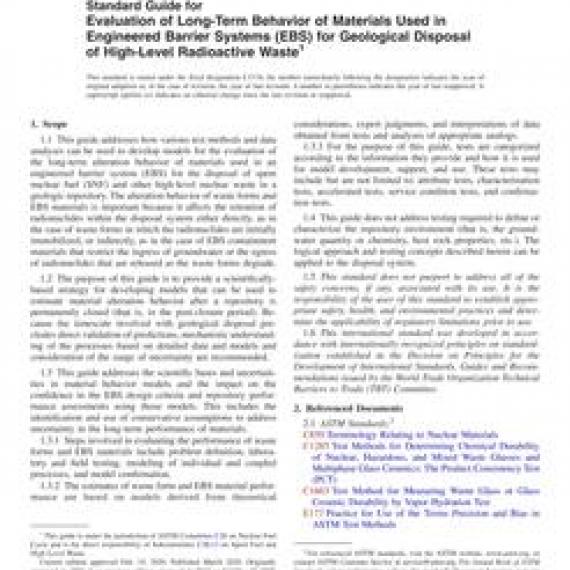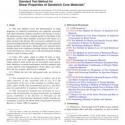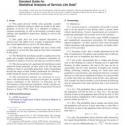No products
ASTM C1174-20
ASTM C1174-20 Standard Guide for Evaluation of Long-Term Behavior of Materials Used in Engineered Barrier Systems (EBS) for Geological Disposal of High-Level Radioactive Waste
standard by ASTM International, 02/15/2020
Full Description
1.1This guide addresses how various test methods and data analyses can be used to develop models for the evaluation of the long-term alteration behavior of materials used in an engineered barrier system (EBS) for the disposal of spent nuclear fuel (SNF) and other high-level nuclear waste in a geologic repository. The alteration behavior of waste forms and EBS materials is important because it affects the retention of radionuclides within the disposal system either directly, as in the case of waste forms in which the radionuclides are initially immobilized, or indirectly, as in the case of EBS containment materials that restrict the ingress of groundwater or the egress of radionuclides that are released as the waste forms degrade.
1.2The purpose of this guide is to provide a scientifically-based strategy for developing models that can be used to estimate material alteration behavior after a repository is permanently closed (that is, in the post-closure period). Because the timescale involved with geological disposal precludes direct validation of predictions, mechanistic understanding of the processes based on detailed data and models and consideration of the range of uncertainty are recommended.
1.3This guide addresses the scientific bases and uncertainties in material behavior models and the impact on the confidence in the EBS design criteria and repository performance assessments using those models. This includes the identification and use of conservative assumptions to address uncertainty in the long-term performance of materials.
1.3.1Steps involved in evaluating the performance of waste forms and EBS materials include problem definition, laboratory and field testing, modeling of individual and coupled processes, and model confirmation.
1.3.2The estimates of waste form and EBS material performance are based on models derived from theoretical considerations, expert judgments, and interpretations of data obtained from tests and analyses of appropriate analogs.
1.3.3For the purpose of this guide, tests are categorized according to the information they provide and how it is used for model development, support, and use. These tests may include but are not limited to: attribute tests, characterization tests, accelerated tests, service condition tests, and confirmation tests.
1.4This guide does not address testing required to define or characterize the repository environment (that is, the groundwater quantity or chemistry, host rock properties, etc.). The logical approach and testing concepts described herein can be applied to the disposal system.
1.5This standard does not purport to address all of the safety concerns, if any, associated with its use. It is the responsibility of the user of this standard to establish appropriate safety, health, and environmental practices and determine the applicability of regulatory limitations prior to use.
1.6This international standard was developed in accordance with internationally recognized principles on standardization established in the Decision on Principles for the Development of International Standards, Guides and Recommendations issued by the World Trade Organization Technical Barriers to Trade (TBT) Committee.


































